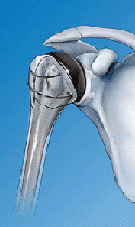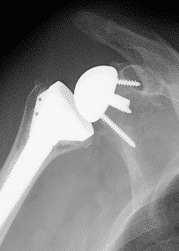
Prosthetic surgery
This procedure is now commonly used, with results that have improved these past 10 years due to major advances in operational techniques and equipment.
The prosthesis allows for glenohumeral joint replacement in cases of inflammatory arthritis, or, more frequently, glenohumeral arthrosis in healthy rotator cuffs. In the latter case, the condition is called centered omarthrosis. Like the hip prosthesis, the humerus’s superior end is replaced by a rod.
The rod carries a metallic sphere that articulates on a moderately concave polyethylene piece, which is secured to the shoulder blade’s glenoid cavity.
This glenohumeral arthrosis occurs when a prior rotator cuff rupture aggravates. This condition is called excentered omarthrosis because the humeral head is higher as compared to the coil.
An “inverted” shoulder prosthesis, in which the humeral sphere is concave and the coil screwed into the shoulder blade is convex, is necessary. This congruence compensates for the rotator cuff’s absence or inadequacy.
The shoulder prosthesis’s humeral component is used in cases of severe thrypsis of the humerus’s superior end in older patients by replacing the humeral head. Bone tuberosities are then reinserted on the humeral rod (greater tuberosity of the humerus and lesser tuberosity of the humerus).
The outcome results regarding pain are usually good, but strength and mobility may not be completely recovered.
Usually, the procedure lasts an hour and a half. Complications are possible (infection, nerve damage, subluxation, etc.). A 5-day hospitalization is necessary, which must be followed by rehabilitation for 3 months


